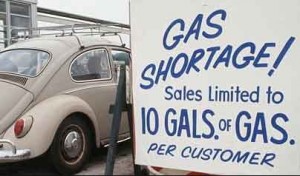 October 17th saw the 40th anniversary of the oil embargo by the Organization of the Petroleum Exporting Countries (OPEC) – a six month embargo that cut the supply of oil to the US and skyrocketed gasoline prices. The days of 25 cents per gallon gasoline were over and the coming years would see desperate attempts to solve the problem. The 1973 embargo started right after the Yom Kippur war was launched, and was spurred by US support for Israel; the second gasoline crisis in 1979, again driving up pump prices and forcing drivers to wait in long lines to fill their tanks, was triggered by another Middle East crisis – the takeover of the US embassy in Iran.
October 17th saw the 40th anniversary of the oil embargo by the Organization of the Petroleum Exporting Countries (OPEC) – a six month embargo that cut the supply of oil to the US and skyrocketed gasoline prices. The days of 25 cents per gallon gasoline were over and the coming years would see desperate attempts to solve the problem. The 1973 embargo started right after the Yom Kippur war was launched, and was spurred by US support for Israel; the second gasoline crisis in 1979, again driving up pump prices and forcing drivers to wait in long lines to fill their tanks, was triggered by another Middle East crisis – the takeover of the US embassy in Iran.
For Keith Crain, editor-in-chief of Automotive News, it was the end of innocence – when automakers had been competing to provide the biggest and best cars to drivers and mileage didn’t really matter at all. The OPEC oil embargo changed all of that; General Motors president Ed Cole vowed to raise the automakers corporate average fuel economy (CAFE) by 50% from 12 mpg to 18 mpg within a decade. The US Congress thought it was very good idea and raised the bar even higher – CAFE was to be 27.5 mpg by the 1985 model year, though that did not happen. For Peter Ward, then with the California Energy Commission, the 1973 oil embargo was the watershed, defining moment illustrating the power of the oil cartel on global economics and clarifying the necessity for alternative fuels.
There were other watershed moments taking place after the initial OPEC embargo….
- “Non-OPEC” oil field drilling started to break dependence on OPEC supply, led by drilling in the North Sea and Alaska.
- The Keystone XL pipeline fight had a predecessor with Alaska’s Prudhoe Bay oil field. It had been stopped by environmentalists in the late 1960s, but Congress approved the pipeline that would eventually add up two million barrels a day to the US supply.
- Alternatives to oil took off – nuclear power and coal became important in electric power stations. Solar energy saw a startup phase that didn’t take hold until very recently.
- Import cars stated being taken seriously in the Detroit 3-dominated US market. Japanese small cars provided the fuel economy, and owners started expecting their cars to be more reliable and long lasting from their experience with these cars.
- In 2008, the US (and the rest of the world) once again experienced the power of oil on the economy. Oil and transportation fuel prices skyrocketed in August 2008; within a month, the Lehman Brothers debacle spurred the Great Recession, and the dramatic oil price increase from the previous month was thought to be instrumental in the recession’s tipping point being passed in September.
As then-president George W. Bush said a few years ago during his State of the Union address, “We’re addicted to oil.” Recovery from oil addiction is being played out now in the federal fuel economy standards; growth in plug-in, hybrid and alternative fuel vehicle launches; development of the alternative fuel and charging infrastructure; California’s (and states following California’s guidelines) zero emission vehicle targets; and demand for green, alternative fuel vehicles from consumers, fleets, municipalities and government agencies, and transportation companies. There’s a still a long ways to go, but oil supply disruption and skyrocketing pump prices continue to be a very motivating force.



